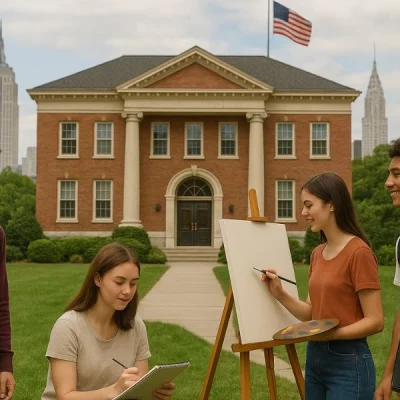How to get into Massachusetts Institute of Technology from India?
Table of Contents
For Indian students, gaining admission to the Massachusetts Institute of Technology (MIT) is a dream that signifies academic excellence, cutting-edge research opportunities, and access to world-class faculty and resources. MIT consistently ranks among the top universities globally, particularly in STEM fields, attracting some of the most talented students worldwide. However, getting into MIT is an extremely competitive process, with an acceptance rate of around 4%, making it one of the most selective institutions.
For Indian students, securing admission requires meticulous preparation, outstanding academic credentials, and a holistic application showcasing intellectual curiosity, leadership skills, and real-world problem-solving abilities. This guide provides a detailed roadmap on how Indian students can navigate MIT’s admission process, eligibility requirements, acceptance rates, and financial aid options.
Why MIT is a Dream Destination for Indian Students?
MIT is considered one of the most prestigious institutions globally, attracting thousands of talented Indian students every year. The university offers an unparalleled academic environment, cutting-edge research opportunities, and strong industry connections, making it a top choice for students aspiring to push the boundaries of innovation and scientific discovery. Following are the key details as to why Massachusetts Institute of Technology is a dream destination for Indian Students:
- The university’s culture of hands-on learning, known as “Mens et Manus” (Mind and Hand), ensures that students gain both theoretical knowledge and practical application skills.
- Additionally, MIT’s proximity to top-tier technology firms, research labs, and venture capital networks provides students with abundant opportunities for internships, startup funding, and collaborative projects.
- Indian student organizations, cultural festivals, and community support systems make it easier for students to adjust to life in the U.S., ensuring they have a fulfilling academic and personal experience.
- For Indian students, gaining admission into MIT is not just about earning a degree—it is about becoming part of a legacy of innovation, research, and transformative leadership.
MIT Admission Process and Eligibility for Indian Applicants
The admission process for Indian students at MIT follows a structured framework. For undergraduate programs, applicants need to apply through the MIT Admissions portal, while graduate applicants must apply through their respective department’s application system. The process involves multiple components, including standardized test scores, recommendation letters, essays, and proof of English proficiency.
MIT also evaluates applicants based on their research potential, problem-solving skills, and ability to thrive in an intellectually stimulating environment. Personal projects, internships, Olympiads, and national/international competition achievements (such as IMO, IPhO, or Google Science Fair) can significantly strengthen an applicant’s profile. For a clearer understanding, here’s a detailed breakdown of the MIT admission process:
| Application Component | Undergraduate Applicants | Graduate Applicants |
| Application Portal | MIT Admissions (apply.mitadmissions.org) | Respective department’s website |
| Standardized Tests | SAT/ACT (highly recommended but optional) | GRE/GMAT (varies by program) |
| English Proficiency | TOEFL iBT (100+), IELTS (7.0+), or Duolingo (if applicable) | TOEFL iBT (90+), IELTS (varies by department) |
| Academic Transcripts | High school transcripts (Class 9-12) | Bachelor’s degree transcripts from a recognized institution |
| Letters of Recommendation | Two evaluations from teachers (preferably one from STEM and one from humanities) | Three recommendations from professors, research advisors, or industry professionals |
| Essays / Statement of Purpose (SOP) | Multiple short-answer essays and a personal statement | Detailed SOP outlining research interests, academic goals, and alignment with MIT faculty |
| Extracurricular Activities | Leadership roles, Olympiads, research projects, innovation competitions | Research experience, published papers, projects, and internships |
| Application Deadlines | Early Action: November 1, Regular Decision: January 5 | Varies by department (usually between December – February) |
| Application Fee | $75 (fee waivers available for eligible students) | $75-$125 depending on the program |
MIT Acceptance Rate for Indian Students: How Competitive is it?
MIT has one of the most selective admissions processes in the world, with an overall acceptance rate of approximately 4%. While the university does not release country-specific acceptance rates, it is estimated that less than 3-5% of Indian applicants receive admission due to intense competition.
Indian students applying to MIT face competition from some of the brightest minds globally, many of whom have exceptional academic records, research experience, and prestigious accolades such as Olympiad medals, published research papers, and top ranks in standardized tests. Following are the key details of MIT Acceptance Rate 2025:
| Category | Details |
| Overall Acceptance Rate | ~4% |
| Estimated Indian Applicants Per Year | 5,000+ |
| Estimated Indian Acceptance Rate | 3-5% |
| Most Competitive Programs | Computer Science, Engineering, Business (MBA), Physics, Biomedical Sciences |
MIT Scholarships for Indian Students: How to Reduce Tuition Costs?
Securing financial assistance is a crucial aspect of pursuing higher education at MIT. The university provides a variety of financial aid options, including scholarships, grants, student employment opportunities, and loans, to ensure that students can afford their education without excessive financial burden. Scholarships and grants, in particular, are highly beneficial as they do not require repayment.
MIT Student Financial Services (SFS) is committed to ensuring affordability for all students, providing need-based scholarships and guiding students through external funding opportunities. Whether through federal and state grants, private scholarships, or MIT’s internal financial aid, students have multiple avenues to reduce the cost of tuition and living expenses. Below is a comprehensive breakdown of the different types of financial aid available at MIT:
| Type of Financial Aid | Description |
| MIT Scholarships | Need-based financial aid provided directly by MIT to students who demonstrate financial need. Awarded to undergraduate students and does not require repayment. |
| Federal Grants | Financial aid provided by the U.S. government to eligible students. Includes Pell Grants, Federal Supplemental Educational Opportunity Grants (FSEOG), and Iraq and Afghanistan Service Grants. |
| State Grants | Some U.S. states provide need-based or merit-based grants. These are automatically applied to financial aid packages for eligible students. |
| Outside Scholarships | Private scholarships from non-MIT organizations, which students can apply for independently to cover tuition and living expenses. |
| Student Employment | Work-study programs and on-campus jobs that allow students to earn money while studying. Helps offset personal expenses and contribute to tuition costs. |
| Loans | Borrowed funds that students or parents can use to cover educational expenses. MIT offers low-interest loan options with favorable repayment terms. |
Conclusion
Getting into MIT from India is undoubtedly challenging, but with meticulous planning, academic excellence, and a well-rounded application, Indian students can significantly enhance their chances. The key is to demonstrate not just strong academics but also problem-solving skills, research potential, leadership qualities, and a passion for innovation. With multiple financial aid options available, studying at MIT is an achievable goal for students who prepare strategically. Whether through scholarships, grants, or external funding, Indian applicants can reduce tuition costs and focus on their academic journey. If you’re an aspiring student looking to study at MIT, start preparing early, engage in research, showcase leadership, and craft a compelling SOP. With determination and the right approach, your MIT dream can become a reality!
Frequently Asked Questions
How difficult is it for an Indian student to get into MIT?
Getting into MIT is extremely competitive, with an overall acceptance rate of about 4%. Indian students face stiff competition from applicants worldwide, and only 3-5% of Indian applicants secure admission. A strong academic record, research experience, leadership skills, and a well-rounded profile significantly improve the chances of getting in.
What are the eligibility requirements for Indian students applying to MIT?
Indian students applying to undergraduate programs must have completed their higher secondary education (Class 12) with outstanding grades. For graduate programs, applicants need a bachelor’s degree in a relevant field. Standardized test scores, such as SAT/ACT (undergrad) or GRE/GMAT (grad), may be required, along with TOEFL/IELTS scores for non-native English speakers.
What is the minimum TOEFL/IELTS score required for MIT?
MIT prefers a TOEFL iBT score of 100+ or IELTS 7.0+. Some departments have higher requirements, so applicants should check their specific program’s language proficiency criteria.
What are the most competitive programs for Indian students at MIT?
MIT’s most competitive programs include:
- Computer Science & Engineering
- Business (MBA)
- Physics
- Biomedical Sciences
- Artificial Intelligence & Robotics
These programs receive thousands of applications globally, making them highly selective.
What is the tuition cost for MIT, and how can Indian students reduce expenses?
The total cost of attendance at MIT, including tuition, housing, and living expenses, is around $80,000 per year. Indian students can reduce costs by applying for scholarships, grants, on-campus jobs, and external funding opportunities.







